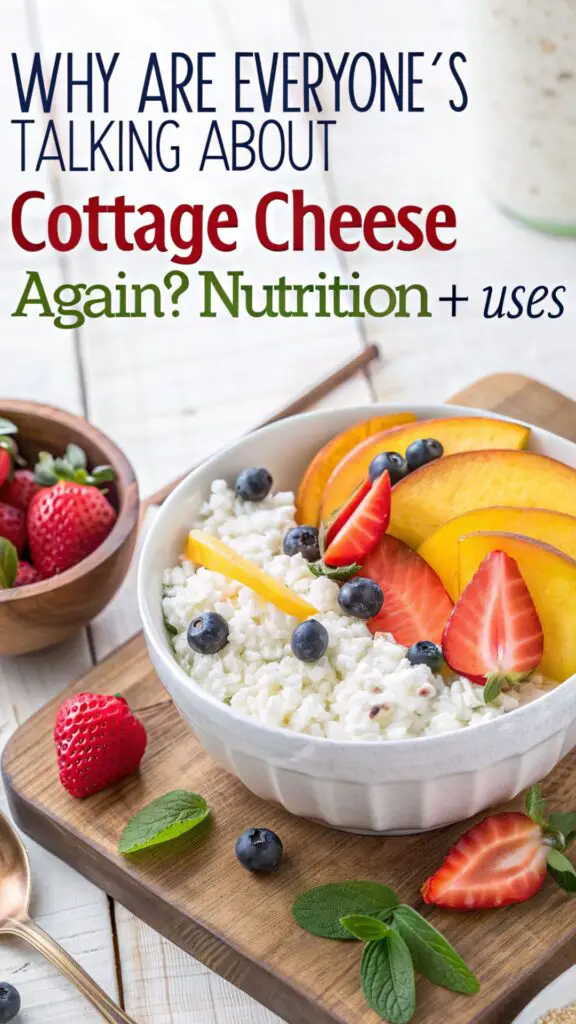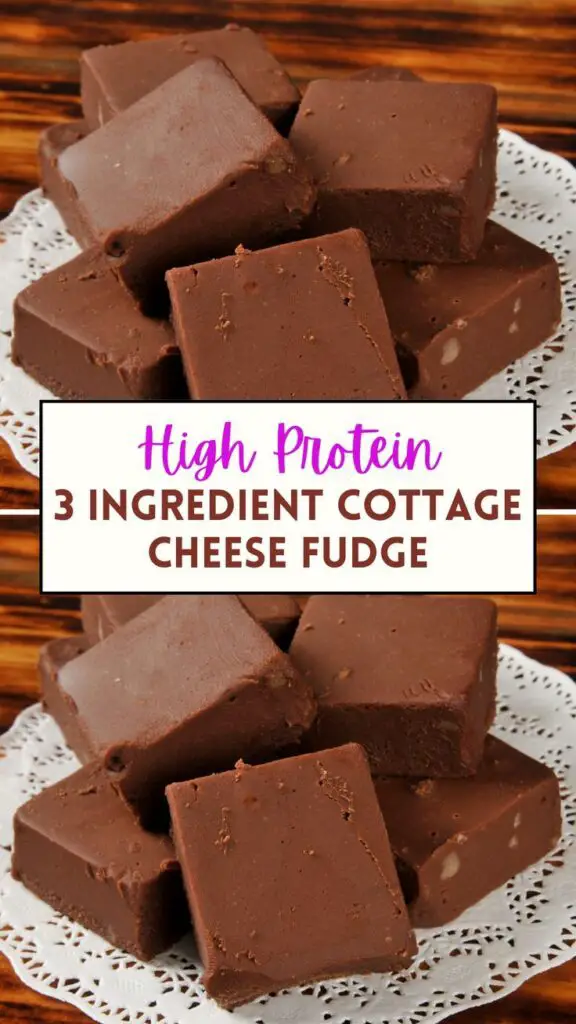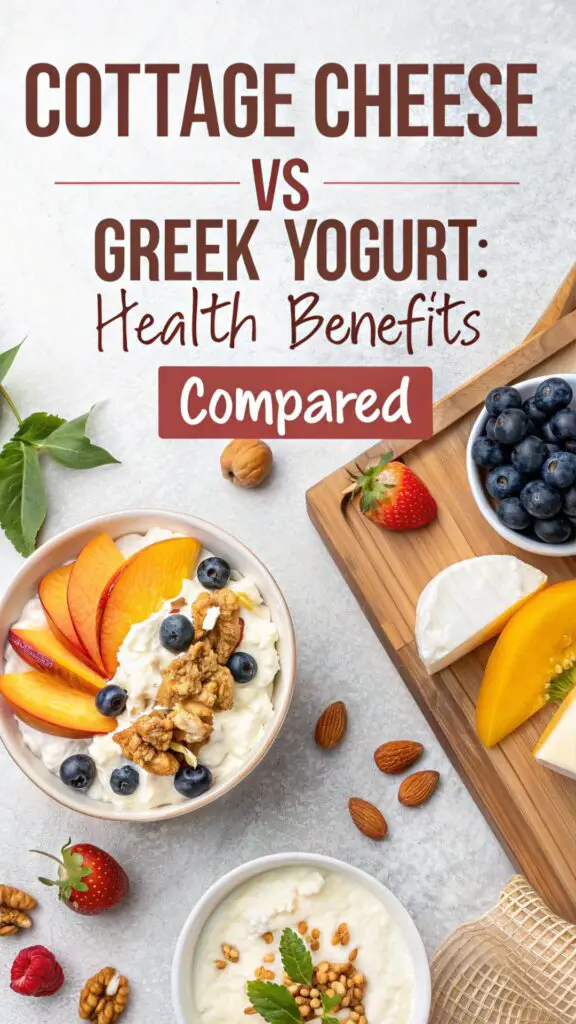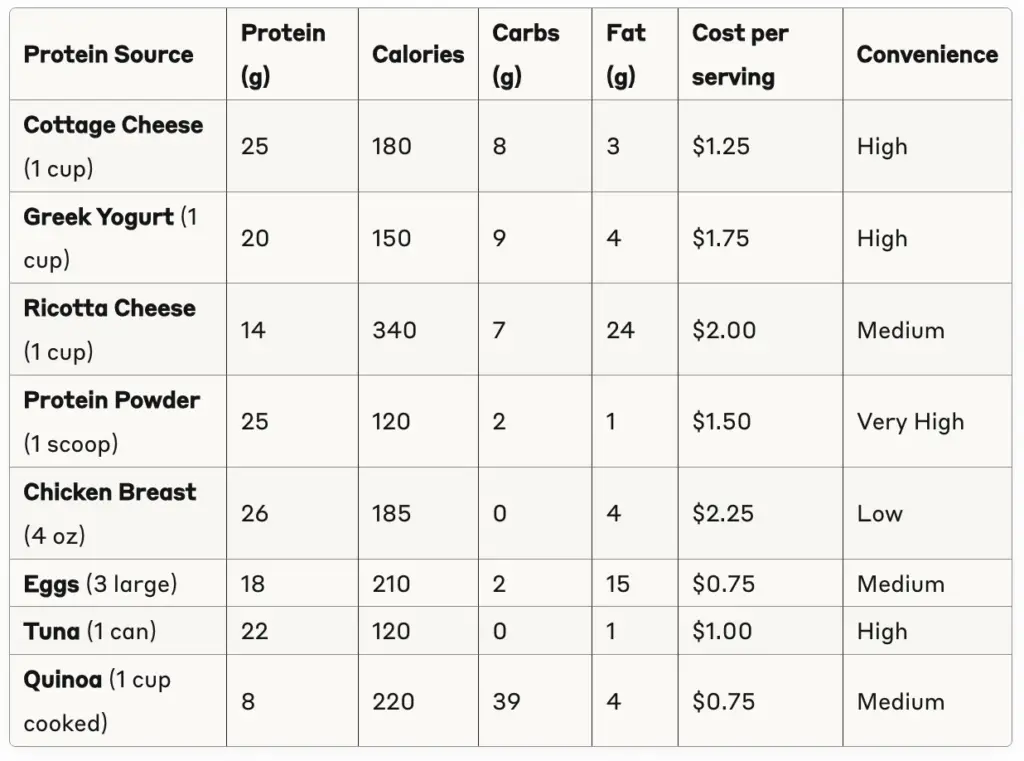Share via:
I’ll admit it—I never thought I’d see cottage cheese trending again. Yet here we are, with my social feeds suddenly full of creamy recipes and inventive ways to use this humble, lumpy cheese.
It’s not just nostalgia fueling the buzz; there’s a real nutritional story behind cottage cheese’s comeback. Once relegated to diet plates and old-school lunchboxes, cottage cheese is now being celebrated for its high protein, low calorie profile, and versatility in both sweet and savory dishes.

The numbers don’t lie either. Cottage cheese sales jumped by 34% in 2024 alone, making it one of the fastest-growing dairy categories.
Brands like Good Culture and Friendship Dairies can barely keep up with demand. Search “cottage cheese recipes” on Pinterest and you’ll find over 500,000 pins – a 400% increase from just three years ago.
So what changed? How did this humble dairy product go from diet culture relic to the protein-packed superstar everyone’s talking about?
Whether it’s being whipped into dips, blended into smoothies, or starring in viral TikTok ice cream bowls, cottage cheese has officially entered its new era—and I’m here for it, curious to explore why everyone’s talking about it again and how best to enjoy its many benefits.
Cottage Cheese Recipes To Try
10 Healthy Cottage Cheese Dessert Recipes
2 Ingredient Cottage Cheese Flatbread
Cottage Cheese Crustless Quiche Recipes

The Great Cottage Cheese Comeback
From Diet Staple to Social Media Star
Let’s take a quick trip down memory lane. Cottage cheese had its moment in the 1970s and 80s when it was practically synonymous with “diet food.” Remember those vintage Weight Watchers ads featuring cottage cheese with a lonely peach half? That was peak cottage cheese fame.
But somewhere in the 90s and 2000s, things went sideways. As diet culture shifted toward fat-free everything and artificial sweeteners, cottage cheese got lumped in with other “old-fashioned” diet foods. Greek yogurt swooped in as the cool, new protein option, and suddenly cottage cheese felt as outdated as leg warmers.
The real game-changer? TikTok creators who weren’t old enough to have those negative associations.
@healthyiscool started the cottage cheese ice cream trend that got 12 million views. @thefoodbabe showed how to make it taste like cookie dough. Suddenly, Gen Z was discovering this “new” protein source and sharing it with their millions of followers.
Then celebrities jumped on board. Kourtney Kardashian posted about her cottage cheese obsession. Fitness influencer Whitney Simmons started featuring it in her meal prep videos. When someone with 3 million followers says they’re eating cottage cheese daily, people pay attention.
What Changed People’s Minds?
The cottage cheese of 2025 isn’t your mom’s cottage cheese. Brands got smart about marketing and flavors. Good Culture launched varieties like blueberry and everything bagel. Friendship introduced whipped versions that are impossibly creamy. Two Percent Greek even created cottage cheese with chocolate chips.
The packaging got a major upgrade too. Gone are the generic plastic tubs that screamed “diet food.” Now you’ll find cottage cheese in sleek containers with modern branding that looks right at home next to expensive Greek yogurts.
But the biggest shift? Our relationship with protein changed completely.
We went from fat-phobic to protein-obsessed. Suddenly, having 25 grams of protein in a single serving wasn’t just acceptable – it was the goal. Cottage cheese started looking less like diet food and more like a protein powerhouse.
Social media also gave people permission to experiment. Instead of eating it plain with fruit (which, let’s be honest, isn’t great), creators showed how to transform it into actually delicious foods. Once people realized you could make cottage cheese taste like dessert while hitting your protein goals, the stigma disappeared overnight.
Cottage Cheese Nutrition Deep Dive
Macronutrient Profile
Let’s talk numbers, because cottage cheese’s nutrition facts are genuinely impressive.
A single cup of low-fat cottage cheese delivers about 25 grams of protein. To put that in perspective, that’s more protein than three large eggs or a 3-ounce chicken breast. For something you can literally eat straight from the container, that’s pretty incredible.
The carb count stays nice and low at around 8 grams per cup, with minimal sugar. Most of those carbs come from lactose, the natural sugar found in dairy. If you’re watching your carb intake or following a lower-carb lifestyle, cottage cheese fits beautifully into your meal plan.
Fat content varies by type, but even full-fat cottage cheese is relatively modest at about 10 grams per cup. The low-fat versions drop that to around 2-3 grams, while fat-free options eliminate it completely. Personally, I think the full-fat versions taste significantly better and the healthy fats help with satiety, but choose what works for your goals.
Calorie-wise, you’re looking at about 220 calories per cup for full-fat, 180 for low-fat, and around 140 for fat-free varieties. That’s a lot of nutrition bang for your caloric buck, especially when you consider how filling and satisfying cottage cheese is.
Micronutrient Benefits
Beyond the macros, cottage cheese is hiding some serious micronutrient treasures.
B-vitamins are where cottage cheese really shines. You’ll get a hefty dose of B12, which is crucial for nerve function and red blood cell formation. This is especially important for anyone following a vegetarian diet, since B12 is primarily found in animal products. One cup provides about 65% of your daily B12 needs.
Riboflavin (B2) and niacin (B3) are also present in significant amounts. These vitamins help your body convert food into energy and support healthy skin and nervous system function.
The mineral profile is equally impressive. Cottage cheese is loaded with calcium – about 14% of your daily needs per cup. But here’s what makes it special: the phosphorus content is almost as high as the calcium, and these two minerals work together for optimal bone health.
Selenium, an important antioxidant mineral, is another standout. One cup provides about 30% of your daily selenium needs, which supports immune function and may help protect against oxidative stress.
Digestive Health Benefits
Here’s where things get interesting from a gut health perspective.
Some cottage cheese varieties contain live probiotics, though not all brands include them. If you see “live and active cultures” on the label, you’re getting beneficial bacteria that support digestive health. These probiotics can help maintain a healthy gut microbiome, which impacts everything from immune function to mood.
The casein protein in cottage cheese is particularly special. Unlike whey protein, which digests quickly, casein breaks down slowly, providing a steady stream of amino acids to your muscles. This makes cottage cheese an excellent choice before bed – your body gets a slow release of protein throughout the night to support recovery and muscle maintenance.
For those with mild lactose sensitivity, cottage cheese might be more tolerable than you expect. The culturing process breaks down some of the lactose, and the protein and fat can slow digestion, reducing the likelihood of digestive discomfort.
Weight Management Benefits
If you’re trying to lose weight or maintain a healthy weight, cottage cheese might become your new best friend.
The satiety factor is huge. That combination of high protein and moderate fat keeps you feeling full for hours. I’ve noticed that when I have cottage cheese for breakfast, I’m not thinking about food again until lunchtime – something that definitely doesn’t happen with a bagel or cereal.
Protein also has what’s called a high thermic effect, meaning your body burns more calories just digesting and processing it. About 25-30% of protein calories are used up in the digestion process itself, compared to only 5-10% for carbs and fats.
The slow-digesting nature of cottage cheese also helps with blood sugar stability. You won’t get the spike and crash that comes with high-carb snacks, which means fewer cravings and more steady energy throughout the day.
Cottage Cheese vs. Other Protein Sources
Comparison Charts

Let’s see how cottage cheese stacks up against other popular protein sources:

Key Takeaways:
- Best Protein per Dollar: Eggs and tuna win, but cottage cheese is close behind
- Highest Protein Density: Cottage cheese and protein powder tie for most protein per calorie
- Most Convenient: Cottage cheese, Greek yogurt, and protein powder require zero prep
- Best for Low-Carb: Cottage cheese beats most dairy options for lower carb content
- Most Filling: The combination of protein, fat, and volume makes cottage cheese exceptionally satisfying
Detailed Comparisons:
Cottage Cheese vs. Greek Yogurt:
- Protein: Cottage cheese wins with 5g more per serving
- Taste: Greek yogurt has more flavor variety available
- Texture: Personal preference – Greek yogurt is smoother, cottage cheese has more substance
- Probiotics: Both can contain beneficial bacteria, check labels
- Winner: Cottage cheese for pure protein goals, Greek yogurt for flavor variety
Cottage Cheese vs. Ricotta:
- Protein: Cottage cheese delivers 11g more protein per serving
- Calories: Ricotta has nearly double the calories
- Cooking: Ricotta works better in baked dishes, cottage cheese better for fresh applications
- Winner: Cottage cheese by a landslide for nutrition
Cottage Cheese vs. Protein Powder:
- Nutrition: Cottage cheese provides whole food nutrition, vitamins, and minerals
- Satiety: Cottage cheese keeps you full longer due to casein protein
- Flexibility: Protein powder mixes into more recipes seamlessly
- Processing: Cottage cheese is minimally processed whole food
- Winner: Cottage cheese for whole food benefits, protein powder for convenience
When to Choose Cottage Cheese
Convenience factors: Cottage cheese requires zero preparation. Open container, grab spoon, done. Try getting 25 grams of protein that easily from chicken or fish.
Digestibility considerations: Many people find cottage cheese easier on their stomach than protein powders or even Greek yogurt. The casein protein digests slowly and gently.
Budget-friendly protein: At about $0.10 per gram of protein, cottage cheese is one of the most economical protein sources available. Compare that to protein bars at $0.25+ per gram.
Versatility in recipes: This is where cottage cheese really shines. You can use it in sweet recipes, savory dishes, as a base for dips, in baking – the options are endless.
Popular Cottage Cheese Uses & Recipes
Breakfast Applications
Cottage Cheese Pancakes are everywhere on social media right now, and for good reason. Blend 1/2 cup cottage cheese with 2 eggs and a pinch of salt, and you’ve got high-protein pancakes that actually taste great. The cottage cheese makes them incredibly fluffy while packing each serving with protein.
Protein-packed smoothie bowls get a major upgrade with cottage cheese as the base. It creates an incredibly thick, creamy texture similar to frozen yogurt. Try blending cottage cheese with frozen berries, a splash of milk, and vanilla extract. Top with granola and fresh fruit for a breakfast that looks like dessert but fuels your day.
Savory breakfast bowls are my personal favorite discovery. Mix cottage cheese with everything bagel seasoning, add sliced tomatoes, cucumber, and avocado. It’s like a deconstructed bagel with cream cheese, but with five times the protein.
French toast made with cottage cheese is game-changing. Whisk cottage cheese into your egg mixture for French toast that’s incredibly creamy and protein-rich. Each slice becomes a complete breakfast that will keep you full for hours.
Snack Ideas That Went Viral
Cottage cheese ice cream started the whole TikTok trend. Blend cottage cheese with frozen fruit and a touch of sweetener, and you get something that genuinely tastes like soft-serve ice cream. The protein content means you can eat a full serving without the sugar crash.
Chocolate chip cookie dough cottage cheese sounds weird but tastes amazing. Mix cottage cheese with a little vanilla extract, maple syrup, and mini chocolate chips. The result is eerily similar to cookie dough but with 25 grams of protein instead of empty calories.
Ranch dip replacement works perfectly for anyone trying to eat healthier at parties. Blend cottage cheese with ranch seasoning packet and use it for veggies. Same flavor, way more protein, significantly fewer calories.
Fruit and granola combinations are classic for a reason. The protein in cottage cheese balances the natural sugars in fruit, preventing blood sugar spikes while satisfying sweet cravings.
Dinner and Lunch Options
Lasagna filling replacement is brilliant for lightening up Italian dishes. Substitute cottage cheese for part of the ricotta in lasagna, and you’ll get more protein with less calories and fat. Most people can’t tell the difference in the final dish.
Tuna salad substitute works surprisingly well. Mix cottage cheese with canned tuna, diced celery, and seasonings for a protein-packed lunch that’s way lighter than traditional mayo-based tuna salad.
Stuffed peppers with cottage cheese make an excellent high-protein meal. Mix cottage cheese with ground turkey, vegetables, and seasonings, then stuff into bell peppers and bake. Each pepper becomes a complete, balanced meal.
High-protein pasta dishes benefit from cottage cheese’s creamy texture. Stir it into pasta with vegetables and herbs for an instant protein boost that doesn’t require additional cooking.
Dessert Transformations
Cheesecake made with cottage cheese is lighter but still incredibly satisfying. Blend cottage cheese with cream cheese, eggs, and sweetener for a high-protein cheesecake that doesn’t leave you in a sugar coma.
Protein muffins get extra moisture and protein from cottage cheese. Replace some of the oil or butter in muffin recipes with cottage cheese for baked goods that actually contribute to your nutrition goals.
Mousse and pudding alternatives are easy with cottage cheese as a base. Blend with cocoa powder and sweetener for chocolate mousse, or with vanilla and fruit for pudding-like desserts.
Frosting for healthy cakes works better than you’d expect. Whip cottage cheese with powdered sugar substitute and vanilla for a protein-rich frosting that’s significantly lighter than traditional buttercream.
How to Choose the Right Cottage Cheese
Reading Labels
Not all cottage cheese is created equal, and reading labels becomes crucial when you’re trying to find the best option.
Ingredient lists should be relatively short and recognizable. Look for: cultured milk, salt, and maybe some stabilizers like guar gum. Avoid varieties with lots of artificial additives, colors, or preservatives you can’t pronounce.
Added sugar is sneaking into flavored varieties. Some brands add surprising amounts of sugar to fruit-flavored cottage cheese. Check the nutrition label – you want minimal added sugars, especially if you’re using cottage cheese as a protein source rather than a dessert.
Sodium content varies wildly between brands. Some cottage cheese contains over 900mg sodium per cup, while others keep it under 400mg. If you’re watching your sodium intake, compare labels carefully.
Organic vs. conventional is a personal choice, but organic varieties often have cleaner ingredient lists and come from grass-fed cows, which can mean better fatty acid profiles.
Texture and Curd Size Options
Small curd vs. large curd affects both texture and how well cottage cheese works in recipes. Small curd blends more smoothly and works better for things like smoothies or baking. Large curd has more texture and works well when you want distinct cottage cheese pieces, like in savory bowls.
Smooth vs. chunky preferences vary widely. Some brands now make whipped versions that are incredibly smooth and creamy. These work well for people who are put off by cottage cheese’s traditional texture.
Brand comparisons matter more than you might think. Good Culture tends to be creamier and less salty. Friendship has a more traditional texture. Two Percent Greek is tangier. Nancy’s has great probiotic varieties. It’s worth trying a few brands to find your preference.
Storage and freshness tips: Always check the sell-by date and choose the freshest container available. Once opened, cottage cheese stays good for about 7-10 days. If you notice any off smell or pink coloring, it’s time to toss it.
Special Dietary Considerations
Lactose-free options are available for those with lactose intolerance. Brands like Lactaid make cottage cheese that’s been treated with lactase enzyme to break down the problematic lactose.
Low-sodium varieties are crucial for anyone watching their salt intake. Some brands make specifically low-sodium versions with 50% less sodium than regular cottage cheese.
Grass-fed and organic choices often have better nutritional profiles, including higher levels of omega-3 fatty acids and CLA (conjugated linoleic acid), which may have additional health benefits.
Plant-based alternatives are emerging for vegans or those avoiding dairy. These are typically made from nuts or tofu and try to mimic cottage cheese’s texture and protein content, though they don’t quite match the nutrition profile of dairy cottage cheese.
Common Cottage Cheese Myths Debunked
Taste and Texture Myths
“It’s too bland” is the most common complaint, but this is easily solved. Plain cottage cheese is meant to be a blank canvas. Add everything bagel seasoning for savory applications, or vanilla extract and sweetener for sweet uses. The blandness is actually a feature – it takes on whatever flavors you add.
“Weird texture” concerns are valid, but there are solutions. If you hate the lumps, buy small curd varieties or blend it smooth. Whipped cottage cheese has solved the texture problem for many people. You can also use it in recipes where the texture gets transformed, like in pancakes or smoothies.
“Only for dieters” is an outdated stereotype. Modern cottage cheese is eaten by bodybuilders for muscle building, by busy parents for quick protein, by athletes for recovery, and by food lovers who’ve discovered how versatile it is in recipes.
Nutritional Misconceptions
High sodium concerns are real for some brands, but not all cottage cheese is created equal. Plenty of low-sodium options exist, and you can even rinse cottage cheese under cold water to reduce sodium content by about 40%.
Processed food vs. natural considerations: Cottage cheese is actually minimally processed. It’s made by adding acid or enzymes to milk to form curds, then draining the whey. This is similar to how cheese has been made for centuries.
Weight loss miracle claims need reality checks. Cottage cheese isn’t magic for weight loss, but its high protein content and satiety factor can certainly support weight management goals as part of a balanced diet.
Complete protein facts are worth understanding. Cottage cheese contains all nine essential amino acids your body needs, making it a complete protein source comparable to meat, fish, or eggs.
Tips for Cottage Cheese Beginners
Getting Started
Best first purchases: Start with a high-quality brand like Good Culture or Nancy’s in small curd, low-fat variety. Avoid fat-free for your first try – it lacks flavor and creaminess that might turn you off permanently.
Gradual introduction works better than jumping in with a full cup. Start by mixing a few tablespoons into smoothies or using it in recipes where other flavors dominate. This lets you get used to the taste and texture gradually.
Flavor masking techniques for picky eaters include blending cottage cheese into fruit smoothies (you won’t taste it), mixing it into pasta sauces, or using it in baking where other ingredients provide the primary flavors.
Texture modification tips: Blend cottage cheese smooth if lumps bother you, or try whipped varieties. You can also mix it with Greek yogurt for a smoother texture while still getting cottage cheese’s benefits.
Storage and Safety
Shelf life guidelines: Unopened cottage cheese lasts until the sell-by date (usually 2-3 weeks from purchase). Once opened, use within 7-10 days for best quality and safety.
Proper storage methods: Always keep cottage cheese refrigerated at 40°F or below. Store it in the main body of the fridge, not in the door where temperatures fluctuate. Keep the container tightly sealed.
Signs of spoilage to watch for include sour or off smells, pink or yellow discoloration, mold growth, or a slimy texture. When in doubt, throw it out.
Meal prep considerations: Cottage cheese works well for meal prep, but keep wet and dry ingredients separated until ready to eat. For example, pack cottage cheese and granola separately to prevent sogginess.
The Future of Cottage Cheese
Market Predictions
Sales growth projections look incredibly strong. Industry analysts predict cottage cheese sales will continue growing by 15-20% annually for the next several years as more consumers discover its benefits.
New product innovations are already hitting shelves. Expect to see more flavored varieties, different textures (like Greek-style cottage cheese), and cottage cheese-based products like protein bars and frozen desserts.
Flavor variety expansions are ramping up. Brands are experimenting with everything from savory flavors like herb and garlic to sweet options like strawberry cheesecake and chocolate.
Packaging improvements continue evolving with more convenient single-serve containers, resealable pouches for on-the-go consumption, and eco-friendly packaging options.
Sustainability Considerations
Environmental impact compared to other protein sources is relatively favorable. Dairy production does have environmental impacts, but cottage cheese provides more protein per environmental unit than many meat sources.
Local dairy support is becoming more important to consumers. Many cottage cheese brands are partnering with local farms and highlighting their sourcing practices.
Packaging waste reduction efforts are underway, with some brands testing reusable containers and others switching to more recyclable materials.
Conclusion
The cottage cheese comeback isn’t just a trend – it’s a rediscovery of a genuinely nutritious food that got unfairly sidelined for decades.
With 25 grams of complete protein per cup, impressive micronutrient content, and incredible versatility in both sweet and savory applications, cottage cheese deserves its moment in the spotlight. The fact that it’s budget-friendly and requires zero preparation makes it even more appealing in our busy lives.
Whether you’re interested in cottage cheese for its protein content, weight management benefits, or simply want to try those viral TikTok recipes, there’s never been a better time to give it a shot. Start small, experiment with flavors, and don’t be afraid to blend it smooth if texture is a concern.
The best part? Unlike many food trends that prioritize Instagram appeal over nutrition, cottage cheese delivers on both fronts. You can make it look beautiful AND fuel your body well.
So next time you’re at the grocery store, grab a container of cottage cheese. Your grandmother was onto something after all – it just took social media to help the rest of us figure it out.
What’s your favorite way to eat cottage cheese? Share your go-to recipes and flavor combinations in the comments – I’m always looking for new ways to enjoy this protein powerhouse!
FAQ Section
Can you eat cottage cheese every day? Yes, cottage cheese can be safely eaten daily as part of a balanced diet. Its high protein content and nutrient density make it an excellent regular food choice. However, watch your overall sodium intake if you’re eating large amounts daily.
Is cottage cheese good for weight loss? Cottage cheese can support weight loss goals due to its high protein content, which increases satiety and has a high thermic effect. However, it’s not a magic weight loss food – it works best as part of a balanced, calorie-appropriate diet.
What’s the difference between cottage cheese and ricotta? Cottage cheese is made from curds that are washed and drained, resulting in a tangier flavor and higher protein content. Ricotta is made from whey and has a smoother texture, milder flavor, and higher calorie content.
How long does cottage cheese last? Unopened cottage cheese lasts until its sell-by date (usually 2-3 weeks). Once opened, use within 7-10 days. Always check for signs of spoilage like off odors, discoloration, or mold.
Can you freeze cottage cheese? You can freeze cottage cheese, but the texture will change significantly – it becomes grainy and separates. Frozen cottage cheese works best for cooking applications like casseroles rather than eating fresh.
Is cottage cheese inflammatory? Cottage cheese is not inherently inflammatory for most people. However, those with dairy sensitivities or intolerances might experience inflammatory responses. The probiotics in some varieties may actually have anti-inflammatory benefits.
What are the best cottage cheese brands? Popular high-quality brands include Good Culture (known for creaminess), Nancy’s (probiotic varieties), Friendship (traditional texture), and Two Percent Greek (tangy flavor). The best brand depends on your texture and flavor preferences.
I am a writer, editor, and publisher of Grillcuisines.com – an online blog dedicated to sharing grilling tips, accessories, and recipes to encourage more people to get outside and grill.
I’m off to find out the different types of grill foods, their seasons, and how to conduct outdoor cooking properly. I’ll also show you some of my grill-worthy cooking tools & accessories!







